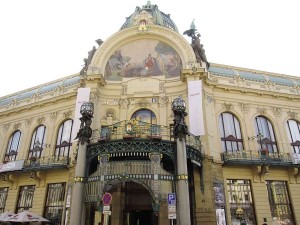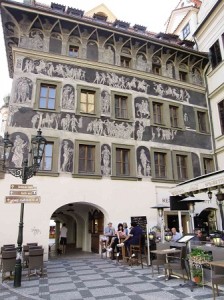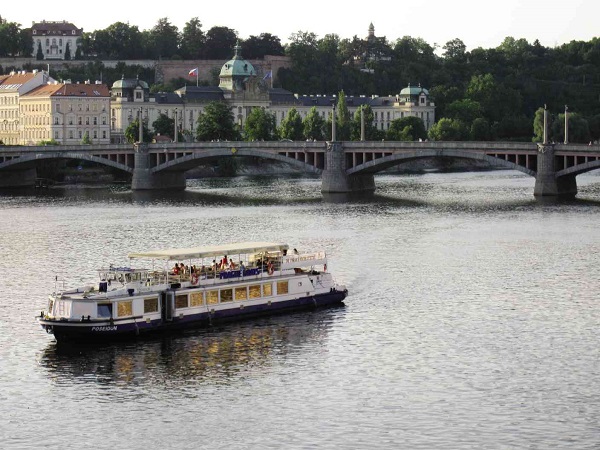
Prague was not on the original itinerary of a family holiday, but its proximity to Budapest made it a stop before we proceeded to Berlin. It looked close enough when viewed from a map but, in fact, the route was a good five-hour leisurely drive. Still, preferred company made it pleasant and enjoyable.
Having this time with the beloved roommate Chito and our daughter Mica for uninterrupted days was premium pleasure. Added to that was the company of good friend Sari and well-traveled brother-in-law Guy behind the wheel.
The scenic route was fragmented by our occasional dozing off until we reached what had been a border control during the Communist era. Guy had selected the hotel in the residential embassy district, next to the exhibition grounds.

The four-star Crowne Plaza Prague is a designated heritage building that served as a Communist headquarters. It was built along the lines of Stalinist architecture, constructed from 1952 to 1954, with stucco over masonry. A green star on the spire distinguishes the façade of the 16-story building, which has a fallout shelter for 600 people now utilized as a staff clothes room.
In search of a shrine
Staré M?sto or Old Town was a 10-minute ride away. Chito was eager to visit the Church of Our Lady of Victory where the statue of the Child Jesus was a major attraction. More widely known in the Philippines as the Sto. Niño, the image draws visitors daily from all over the world.

The church, which is dedicated to the Blessed Mother and San Antonio de Padua, is also a Unesco World Heritage Site. It is in the Lesser Town in Prague on cobblestone Karmelitská Street, across the Mandarin Oriental Hotel. The luxury hotel and spa used to be a 14th century monastery and has preserved period architectural features while integrating contemporary design and conveniences.
It was deemed best to proceed on foot at Old Town. Most everyone was walking the stone-paved alleyways bounded by shops, cafes and cathedrals, some of which have stood for centuries. It was a visual experience of Gothic, Baroque, Rococo, Medieval and Art Nouveau buildings in one stretch after another. There were charming sights along the little paths that narrowed, then turned and opened up to squares or more tapered straits. Getting lost was part of the adventure of discovering a new place.
Music on Charles Bridge

We eventually found ourselves in Staré M?sto Old Town Square a few minutes before the Orloj or Astronomical Clock could mark the hour. The giant time keeper was gathering an audience of spectators anticipating a tableau with the crowing of a cock and the figure of Death brandishing an hour glass, as three other statues did a full turn. It was over very quickly and we resumed our walk to find the shrine of the Infant God.
Our pace was slow to accommodate taking photos and to allow us to pause to read about a chamber concert in a chapel or an opera performance in the theater. It was becoming apparent to us that a few more days were necessary for us to enjoy “Don Giovanni” or the Sonatina in one of Praha’s halls. Franz Kafka lived around these parts, and a visit to where he wrote might have enhanced an excursion to the Prague Castle with his Das Schloss providing a surreal atmosphere.
Following instructions from a shop keeper, we reached the Charles Bridge, which generated a life of its own, with artists sketching and string quartets playing Mozart to passers-by. It was said that Mozart felt much more appreciated in Prague than in his native Austria. An oft-repeated quote attributed to him, “Meine Prager verstehen mich” (“My Praguers understand me”) conveys his sentiments about the city where his opera, “The Marriage of Figaro,” was received with accolades.

Prayer by a closed door
The Charles Bridge is like an open museum of sculptures with 75 bronze statutes depicting different saints and biblical figures along the walls of the stone walkway. It was built in the 14th century over the Vltava River which runs through the heart of the city. Early settlers established themselves along the water and developed trade routes that brought goods as well as people. A panoramic view of the city spreads out from the bridge, with the water washing up on the banks of Old Town and New Town on one side, and Lesser Town on the opposite embankment.
The destination was towards the other end, away from the touristy area. It got more quiet, with less people on the road. We saw them in pubs where beer is staple. Microbreweries do good business in the Czech Republic—the country reputedly has the greatest number of beer drinkers in the world.
It seemed strange that, for a much visited attraction, the street leading up to the church was practically empty. We imagined having to queue at the entrance, recalling the considerable devotees of the Sto. Niño in the Philippines. Our puzzlement was resolved when we arrived in the elevated shrine. It was already closed and the most we could do was say a prayer by the shut door.
Havel’s favorite table
We guessed our way back, taking a different route based on a map. It was, however, the kindness of the locals that helped us get our bearings, by which time we were famished and tired. The enthusiasm to try food particular to the place had dissipated with fatigue and, for a while, it seemed that the first option that presented itself would be a venue for dinner. Memory is unclear on who bravely thumbed down the international food chain and another canteen-like eatery, but the third choice was a find.
It seemed nondescript from the outside but neighborhood folk were patronizing it, which was as good as a recommendation. Our motley band made its way to the back corner of the restaurant and settled in dark wood chairs around a table. Ordering from the menu was our first agenda before taking in the atmosphere.
The bar with gleaming copper dome overhead was obviously a focal point, with beer as the main draw. It turned out that we had entered Kulatak, a known place for pilsner. This one on Vitezne Namesti 820/12 | Dejvicka claimed to be the original over the many others that had opened around the city.
It was only when the generous servings of meats and sausages, cabbage and breads were vanquished that we noted a marker on the wall behind us. A gold plaque indicated that the very table we had selected was Vaclav Havel’s favorite spot. We had shared the space with history, even if the first President of the Czech Republic had not been there to sit with us.
The next day, we were hosted by Chito’s friend, the Philippine Ambassador to the Czech State, Evelyn Austria-Garcia. Her choice for lunch was Kulatak, but a different branch in a more picturesque area. She ordered a spread like a Filipino fiesta. The restaurant seemed newer, brighter and more spacious. Ice cream was a nice finishing touch on a hot day, but Havel had already provided the most memorable meal we had in Prague. That was hard to top.













































